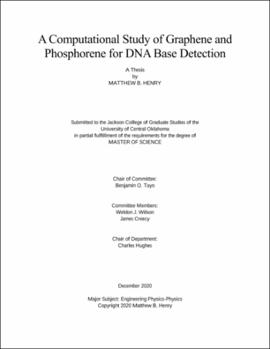| dc.description.abstract | Research into methods of deoxyribonucleic acid (DNA) sequencing has been improving with the goal of providing fast and cheap sequencing of longer strands as accurately as possible. One possible way of improving the process is utilizing a solid-state device. In fact, it has been shown in previous studies that two-dimensional (2D) materials such as graphene, molybdenum disulfide, and hexagonal boron nitride can be used to detect individual DNA bases [2, 3]. Graphene's success for nanopore DNA sequencing has shown that it is possible to explore other potential single- and few-atom thick layers of 2D elemental materials beyond graphene, and also that these materials can exhibit fascinating and technologically useful properties for DNA base detection that are superior to those of graphene. One material of interest is monolayer black phosphorus, or phosphorene. Phosphorene shares many of the remarkable properties of graphene including high carrier mobility [30] and tunable optical properties [32]. The advantage of phosphorene is its direct band gap [31] that is also dependent on thickness, making phosphorene ideal for electronic and optoelectronic applications [33]. It is therefore extremely important to perform exploratory studies to determine phosphorene's ability to detect individual DNA bases as this material is currently being sought after by many experimental groups as a promising material for designing nano-bioelectronic devices for high-speed DNA sequencing. In this thesis, using density functional theory calculations, we find that single-layer phosphorene is an extraordinary material for DNA sequencing using two advanced detection modalities (i.e., nanopore and nanoribbon). We observe that binding energies of DNA bases using nanopores and nanoribbons of phosphorene are smaller compared to graphene devices. This shows that minimal sticking of DNA bases to phosphorene's surface is expected for phosphorene devices. Furthermore, both nanopore and nanoribbon devices from phosphorene show a characteristic change in the density of states for each base. The band gap of phosphorene is significantly changed compared to other nanomaterials (e.g., MoS2, graphene, silicene, h-BN, and silicon nanowire) due to physisorption of bases on the nanoribbon surface. We also observe that the nanoribbon device performs better than the nanopore devices. Our findings confirm our hypothesis that phosphorene is a promising material for DNA base detection using advanced detection principles such as transverse tunneling current measurements. These results will provide valuable insights for other researchers in this field. Ideas for future research include examining this system using a periodic calculation; simulating a real device and calculating the current spectrum; and expanding the research to include other single-layer materials such as transition-metal dichalcogenides and Van der-Waals heterostructures. | en_US |
